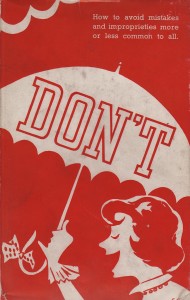According to one of Jot 101’s favourite works of reference, Everybody’s Best Friend (c1939), these are some of the rules of etiquette that prevailed at the onset of the Second World War.
Should a man offer a seat to a woman ?
‘…a courteous man has no hesitation in standing so that a lady may be seated. The exception is that no one would desire an elderly man to give up his seat to a girl…When offered a seat a woman should always accept it readily, with a smile and word of thanks. To decline the offer is to slight a man who is doing the right thing…’
Should visitors smoke ?
Smoking is so general nowadays that men are inclined when visiting to light a cigarette without giving the matter a thought. But strictly, I suppose, a man should never smoke in another person’s house until he has asked permission to do so?
The real answer is that a man should never smoke in another person’s house until permission has been given him unsought…But if a guest asks permission to smoke it is difficult for a hostel to refuse it. Hence the considerate guest —especially when he does not know his hostess’s views on the matter—refrains from smoking until he is invited to do so.
Powdering in public.
It seems to be the usual thing now to see girls making up openly in tea rooms, cinemas and so on. But surely it is not accepted as being quite the right thing to do?
It is not a correct thing to do—and many a girl prefers not to reveal too openly how much her complexion owes to mart instead of nature !Some young men are not altogether guiltless in this respect, for not infrequently one sees them vigorously using a comb or nail-file even at table.
Escorting ladies.
Where should a man walk when escorting two ladies—near the edge of the pavement, or in the centre?
The man should walk on the outside, near the edge f the pavement, as when with one lady only. Where the ladies vary to any extent in age, the more elderly of the two should be in the centre.


Nice post. It really describes what does it mean to be a lady and a gentleman. Classy lady and gentleman.